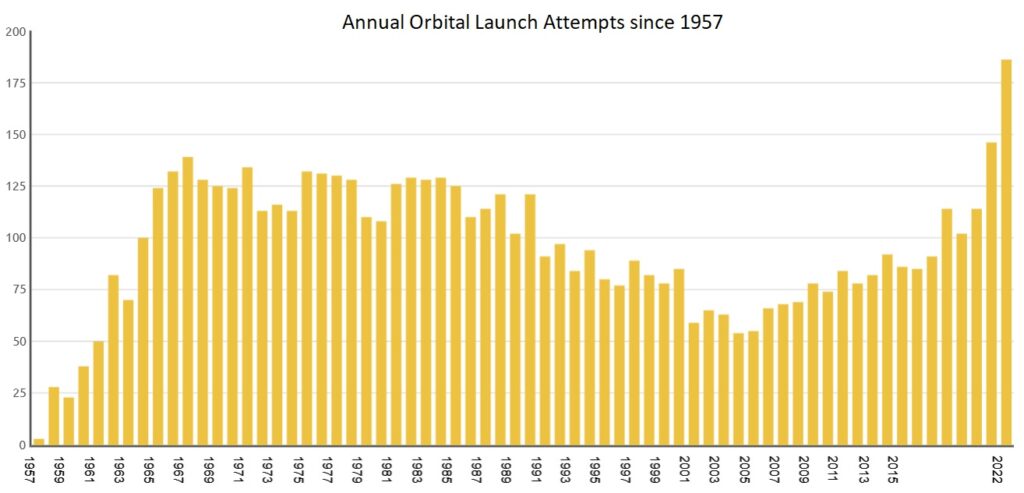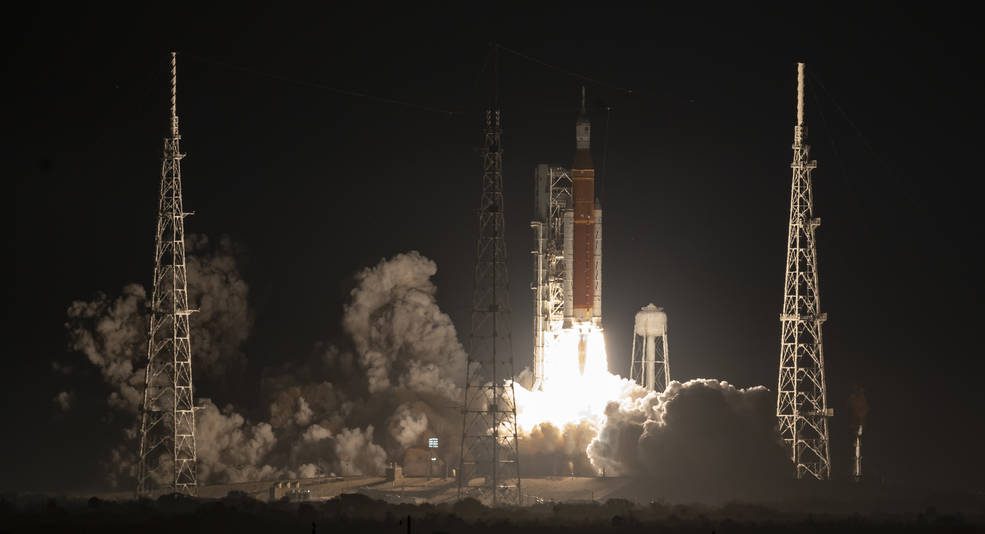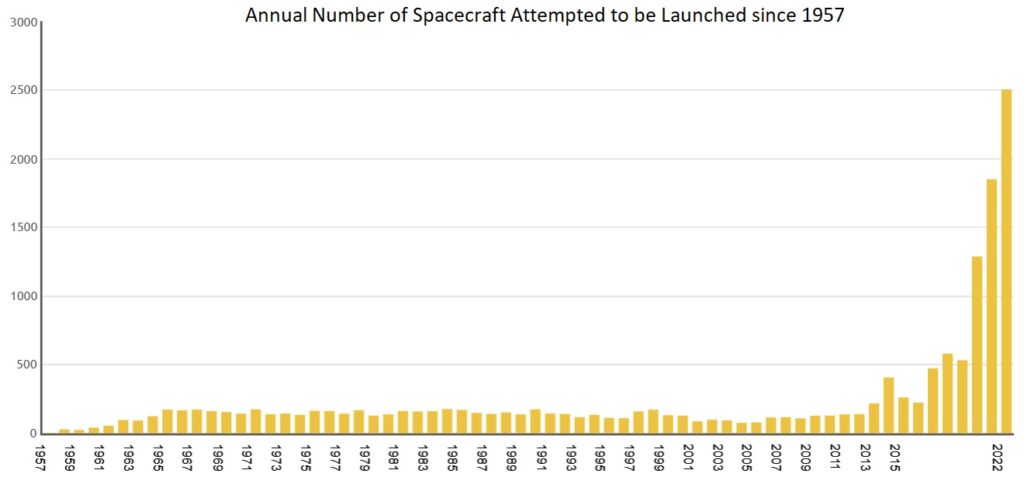During 2022 there were 186 orbital launch attempts. This beat 2021’s record-breaking total of 146 launches (the previous record was in 1967 with 139 launches).
Thanks to the 61 launches made by SpaceX’s Falcon 9/Falcon Heavy family, the US retook the lead with 78, followed by China at 64 (which again broke its own record), and Russia at 21. New Zealand, thanks to Rocket Lab’s Electron rocket, came fourth with nine launches. France (via Arianespace) and India came in at six and five launches, respectively. South Korea, Japan and Iran all had one apiece.
Some 2,510 spacecraft attempted to reach orbit and the number that actually reached a stable orbit was 2,488. This compares with 1,849 satellite orbital attempts in the previous year, of which 1,825 achieved orbit. Again, it was SpaceX that was responsible for the US “taking the crown” with 2,097 of the total. China came in second at 184, with India joint third with Russia at 52. Probably the most important launch of the year, in terms of national space programmes, was that of the SLS, which successfully launched NASA’s long awaited uncrewed Artemis I mission to the Moon.
A couple of notes: we are still trying to confirm how many spacecraft were lost on the Zhuque-2 launch failure. We now believe there were three: Zhixing 1B and two other mystery satellites. Seradata counts the orbital modules of Shenzhou spacecraft as separate spacecraft themselves. The original Shenzhou missions used the Orbital Module for experimentation after the human-carrying re-entry capsule departed for re-entry, and this may or may not be carrying on. The KARI dummy cubesats, LOFTID, and OMD-1 are counted as spacecraft. We have also listed Intruder 13B, which may still be stuck to Intruder 13A. However, it may not exist at all if Intruder 13A (USA 327) is a new design of singular ocean surveillance/signals intelligence spacecraft.
With respect to actual ownership, the US – thanks to Starlink – again dominated the figures.
As to which nation owned the most spacecraft launched, it was the US with 1,957 – again thanks to Starlink. China took second spot with 180 satellites attempted to be launched. The UK took third place with 117, mainly via the ownership registration of the OneWeb constellation.
Eight launch failures but the failure rate declined
Of the 186 launch attempts only eight were classed as failures resulting in a relatively low 4.3 per cent failure rate. The more usual annual launch failure rate is closer to 7 per cent.
The first launch failure of the year was the privately developed US launch vehicle Astra Rocket 3.3, with four cubesats (BAMA-1, INCA, QUBESAT, R5-S1), funded by NASA’s ElaNa 41 programme. It failed on 10 February after its clamshell fairing failed to separate before ignition of the second stage occurred (second stage is fully enclosed by the fairing). All four cubesats were lost.
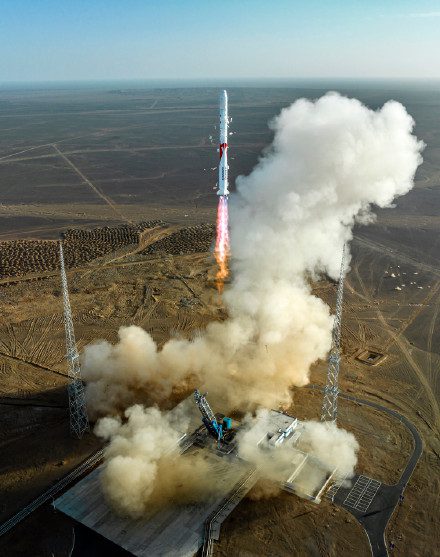
The flame from the Zhuque-2 rocket looked beautiful as it launched. Unfortunately it did not reach orbit. Courtesy: Landspace
On 13 May came the launch failure of the private Chinese launch vehicle, the Hyperbola 1/SQX-1 Upgraded. It failed due to an attitude control system leak on the second stage and lost the Jilin 1 Mofang 01A (R) satellite, a fourth-generation Earth observation satellite that was supposed to replace another one destroyed in a launch failure.
On 12 June, another Astra Rocket 3.3 launch failure doomed a pair of NASA owned weather research satellites, TROPICS 1 and 2. The cause was premature propellant exhaustion on the second stage.
On 7 August it was India’s turn. Its SSLV had a VTM fourth-stage burn failure that resulted in an unstable orbit, from which the EOS-02 Earth observation satellite and the Azaadsat student spacecraft almost immediately re-entered.
The year’s fifth launch failure, involving a Firefly Alpha launch vehicle on 1 October, was a partial failure. The NASA sponsored TechEdSat-15 plus six other cubesats (FossaSat 1B-2, Genesis-G and -J, Qubik-3 and -4, Serenity II) were left a much lower orbit than planned as the result of an underperformance on the Firefly Alpha second stage. The result was that the satellites were in orbit for only a few days, much less than was expected. Despite this, at least some of the satellites were reportedly able to complete their missions.
The launch failures in October did not end there. On 12 October, an Epsilon 2 ADV CLPS did not achieve orbit due to an attitude control failure on its second stage. As a result, seven small satellites were lost: FSI-Sat, Kosen-2, Magnaro, Mitsuba, QPS-SAR 3 and 4 (which are thought to have been insured), Raise-3 and Waseda-Sat-ZER.
It was not until the final month of the year that launch failures resumed. First was the Zhuque 2 on its maiden flight carrying Zhixing 1B plus two other, as yet unidentified, satellites. Its second-stage vernier engine failed.
There was one more failure to round off the year. The Arianespace operated Vega-C had a solid rocket failure on its second flight. Two Pleiades-Neo spacecraft, Pleiades-5 and -6, were destroyed, incurring an insurance loss of over US$200 million.
Human spaceflight
Including three New Shepard suborbital launches, there were 10 flights carrying humans during the year, with a total of 42 space travellers (astronaut crew and space tourists/participants) on board. All were successful.
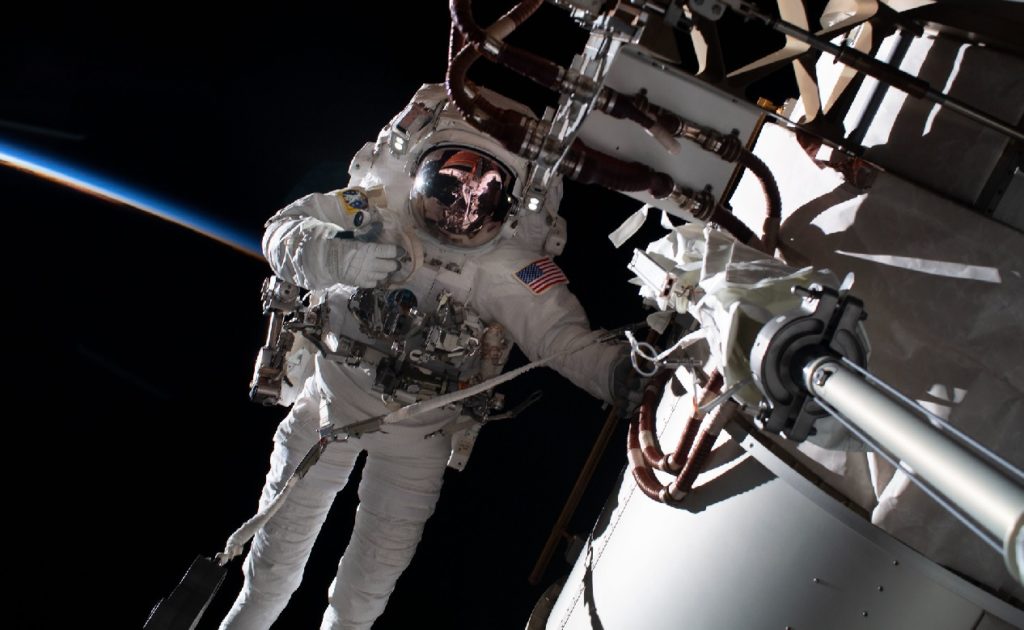
Astronaut Frank Rubio on the 254th spacewalk in support of the Space Station assembly. Courtesy: NASA
The space industry looks forward to some key launches in 2023. Probably the most important in terms of the future of spaceflight is the SpaceX Starship/Super Heavy combination maiden flight. If successful, it will prove to be the largest and best-value heavy-lift launch vehicle ever launched. If it can re-enter its upper stage, it will prove that a totally reusable orbital launch vehicle is practical (note that a full landing will not be attempted on the maiden flight). Other important rockets debuting in 2023 include the Japan’s H-3, ULA’s Vulcan and the European Ariane 6 towards the end of the year.

